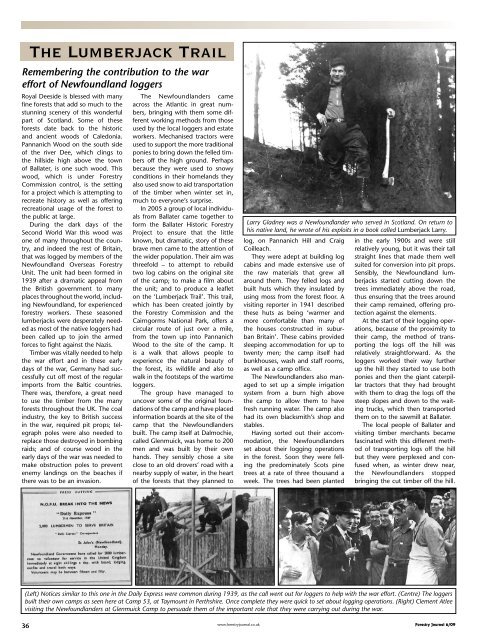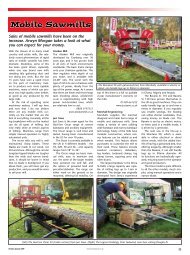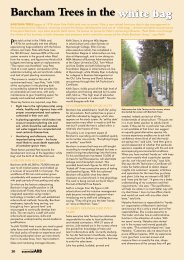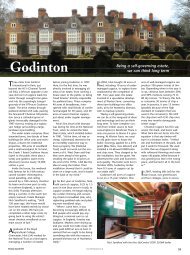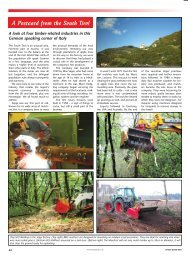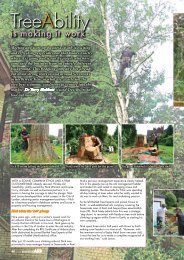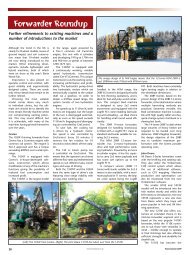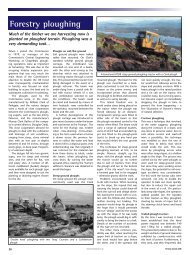Newfoundland Loggers - Forestry Journal
Newfoundland Loggers - Forestry Journal
Newfoundland Loggers - Forestry Journal
Create successful ePaper yourself
Turn your PDF publications into a flip-book with our unique Google optimized e-Paper software.
The Lumberjack TrailRemembering the contribution to the wareffort of <strong>Newfoundland</strong> loggersRoyal Deeside is blessed with manyfine forests that add so much to thestunning scenery of this wonderfulpart of Scotland. Some of theseforests date back to the historicand ancient woods of Caledonia.Pannanich Wood on the south sideof the river Dee, which clings tothe hillside high above the townof Ballater, is one such wood. Thiswood, which is under <strong>Forestry</strong>Commission control, is the settingfor a project which is attempting torecreate history as well as offeringrecreational usage of the forest tothe public at large.During the dark days of theSecond World War this wood wasone of many throughout the country,and indeed the rest of Britain,that was logged by members of the<strong>Newfoundland</strong> Overseas <strong>Forestry</strong>Unit. The unit had been formed in1939 after a dramatic appeal fromthe British government to manyplaces throughout the world, including<strong>Newfoundland</strong>, for experiencedforestry workers. These seasonedlumberjacks were desperately neededas most of the native loggers hadbeen called up to join the armedforces to fight against the Nazis.Timber was vitally needed to helpthe war effort and in these earlydays of the war, Germany had successfullycut off most of the regularimports from the Baltic countries.There was, therefore, a great needto use the timber from the manyforests throughout the UK. The coalindustry, the key to British successin the war, required pit props; telegraphpoles were also needed toreplace those destroyed in bombingraids; and of course wood in theearly days of the war was needed tomake obstruction poles to preventenemy landings on the beaches ifthere was to be an invasion.The <strong>Newfoundland</strong>ers cameacross the Atlantic in great numbers,bringing with them some differentworking methods from thoseused by the local loggers and estateworkers. Mechanised tractors wereused to support the more traditionalponies to bring down the felled timbersoff the high ground. Perhapsbecause they were used to snowyconditions in their homelands theyalso used snow to aid transportationof the timber when winter set in,much to everyone’s surprise.In 2005 a group of local individualsfrom Ballater came together toform the Ballater Historic <strong>Forestry</strong>Project to ensure that the littleknown, but dramatic, story of thesebrave men came to the attention ofthe wider population. Their aim wasthreefold – to attempt to rebuildtwo log cabins on the original siteof the camp; to make a film aboutthe unit; and to produce a leafleton the ‘Lumberjack Trail’. This trail,which has been created jointly bythe <strong>Forestry</strong> Commission and theCairngorms National Park, offers acircular route of just over a mile,from the town up into PannanichWood to the site of the camp. Itis a walk that allows people toexperience the natural beauty ofthe forest, its wildlife and also towalk in the footsteps of the wartimeloggers.The group have managed touncover some of the original foundationsof the camp and have placedinformation boards at the site of thecamp that the <strong>Newfoundland</strong>ersbuilt. The camp itself at Dalmochie,called Glenmuick, was home to 200men and was built by their ownhands. They sensibly chose a siteclose to an old drovers’ road with anearby supply of water, in the heartof the forests that they planned toLarry Gladney was a <strong>Newfoundland</strong>er who served in Scotland. On return tohis native land, he wrote of his exploits in a book called Lumberjack Larry.log, on Pannanich Hill and CraigCoilleach.They were adept at building logcabins and made extensive use ofthe raw materials that grew allaround them. They felled logs andbuilt huts which they insulated byusing moss from the forest floor. Avisiting reporter in 1941 describedthese huts as being ‘warmer andmore comfortable than many ofthe houses constructed in suburbanBritain’. These cabins providedsleeping accommodation for up totwenty men; the camp itself hadbunkhouses, wash and staff rooms,as well as a camp office.The <strong>Newfoundland</strong>ers also managedto set up a simple irrigationsystem from a burn high abovethe camp to allow them to havefresh running water. The camp alsohad its own blacksmith’s shop andstables.Having sorted out their accommodation,the <strong>Newfoundland</strong>ersset about their logging operationsin the forest. Soon they were fellingthe predominately Scots pinetrees at a rate of three thousand aweek. The trees had been plantedin the early 1900s and were stillrelatively young, but it was their tallstraight lines that made them wellsuited for conversion into pit props.Sensibly, the <strong>Newfoundland</strong> lumberjacksstarted cutting down thetrees immediately above the road,thus ensuring that the trees aroundtheir camp remained, offering protectionagainst the elements.At the start of their logging operations,because of the proximity totheir camp, the method of transportingthe logs off the hill wasrelatively straightforward. As theloggers worked their way furtherup the hill they started to use bothponies and then the giant caterpillartractors that they had broughtwith them to drag the logs off thesteep slopes and down to the waitingtrucks, which then transportedthem on to the sawmill at Ballater.The local people of Ballater andvisiting timber merchants becamefascinated with this different methodof transporting logs off the hillbut they were perplexed and confusedwhen, as winter drew near,the <strong>Newfoundland</strong>ers stoppedbringing the cut timber off the hill.(Left) Notices similar to this one in the Daily Express were common during 1939, as the call went out for loggers to help with the war effort. (Centre) The loggersbuilt their own camps as seen here at Camp 53, at Taymount in Perthshire. Once complete they were quick to set about logging operations. (Right) Clement Atleevisiting the <strong>Newfoundland</strong>ers at Glenmuick Camp to persuade them of the important role that they were carrying out during the war.36www.forestryjournal.co.uk<strong>Forestry</strong> <strong>Journal</strong> 6/09
Lots of activity in the camp at Ballater. Note the logs being pulled by Garronponies.The autumn rains had turned theirtrails and tracks into muddy quagmires,unable to provide safe andsustainable routes for getting thelogs down to Ballater.The loggers seemed to be unconcernedwith this problem and continuedto cut down the trees withgreat gusto. They stacked themhigh up on the hills close to wherethey grew. As the log piles becamesteadily bigger those looking on hadno idea what the <strong>Newfoundland</strong>ershad in mind. The first onset of heavywinter snows soon allowed them toshow all and sundry just what theyhad been planning. The deep snowwas used to literally slide the logsoff the hillside on wooden sledgesdragged by Garron ponies.The work of the loggers washard, with ten-hour shifts, six daysa week, for a reward of only $2 perday, $1 of which they had to sendback home to <strong>Newfoundland</strong>. Fromthis money they also had to pay fortheir tools and clothing! They hadmost of their food prepared on siteand they supplemented their normaldiet of pickled beef and pork withbread, pies and cakes. They weresuspicious of many things that camefrom outside the camp, but they didenjoy attending the local Saturdaynight dances that took place inBallater and other surrounding villages.These allowed them a chanceto unwind from their daily toils andhard work on the hill.Such was the importance of thework, that when many of the loggersdecided at the end of theirinitial six-month contracts to enlistor to return home, the then DeputyPrime Minister, Clement Atlee, journeyednorth to persuade them howvital their work was to the overallwar effort. He was mostly successfulin his pleas and after this crisis moremen were recruited to the cause,this time on longer contracts thatwere for the duration of the war,and a potentially disastrous situationwas averted. Many, though,still wanted a chance to fight againstthe Nazi tyranny.Later the loggers did get theirchance to serve by forming theirvery own Home Guard unit; thisunit at its height had over 700<strong>Newfoundland</strong>ers in its ranks. Themen showed their commitment byspending most of their spare timetraining to defend the Highlandsagainst a German invasion. Theytrained on purpose-built assaultcourses and took part on many fieldexercises, but never had to face theenemy for real. Their commitmentto Britain’s war effort could notbe questioned; thirty-four graves invarious lonely cemeteries throughoutthe country are testimony tothis. The inclement weather andsome fatal accidents while carryingout their vital and dangerous workare the reasons noted on many ofthe headstones that stand alone inthese quiet country graveyards.Two years was all it took to stripPannanich wood and then the loggersmoved on to other camps. Bythe war’s end a massive reforestationwas required to make sure thatthese Scottish hillsides would returnto their former glory. A mixtureof native Scots pine and importedDouglas fir were used, perhaps fittingly,allowing a North Americanpresence to remain in the area yearsafter the loggers had left.Edgar Baird, the manager of theunit, was quoted at that time assaying that, following the replantingat Pannanich Wood, in 30 years’time the hill would be unrecognisableas the barren, desolate placeit was when the <strong>Newfoundland</strong>ersdeparted. For a period after this,Italian and German POWs took overthe recently vacated cabins, thusoffering yet another historical perspectiveto this Scottish woodland.1200 loggers remained to helpthis reforestation process and continuedto assist the forestry industryto get back to its pre-war productionlevels. In 1946 the unit wasofficially disbanded. By then manylocal workers had returned andtaken over the forestry labours. Themajority of the <strong>Newfoundland</strong>ersreturned home, some with localgirls, but a few were so taken by theHighlands that they actually marriedand settled in the area.A visit to Ballater nowadays,starting at the Old Royal Station,allows visitors the opportunity towatch the DVD A Bygone Forest.This short film, made by the Ballatergroup with the help of a grantfrom the Lottery and support fromthe <strong>Forestry</strong> Commission, retells theloggers’ story. It also provides a veryinteresting forerunner to the walkup to the actual campsite.The station, famous for its royalconnections, was the start of theexit route that the prepared timbertook as it was transported awayfrom the area southwards. It alsohad a popular bar which was frequentedby the loggers and localsduring the Second World War.Following the Lumberjack Trail upfrom Ballater, you literally stumbleacross the former camp site as youwalk around a corner on this beautifulwoodland walk.As you stand there in the forestit is possible to imagine thefar-gone cries of ‘timber’ that the<strong>Newfoundland</strong>ers must have madeas they felled tree after tree. Walkingthough the forest, if you look carefully,there are still remnants of theloggers’ camp to be seen lying allaround. In fact, the site of the campmidden would no doubt offer mucharchaeological data on the campitself, if it were ever excavated, TimeTeam style.The film, the trail, informationleaflets and boards, as well as theplans for a full-blown interpretiveheritage centre to be housedin the two reconstructed huts atDalmochie are all going to ensurethat these brave men are rememberedfor many years to come inthe Deeside area. This centre, whencompleted, will be a fitting tributeto them and it will also allow visitors,in particular schoolchildren, tounderstand the rich history of forestryon Deeside.James HendriePictures courtesy NOFU/GladneyWebsite: http://www.mgl.ca/~cpike/NOFU.html(Left) Camp 51 at Kildrummy, west of Aberdeen, where the loggers operated between 1940/41. (Centre) Glenmuick Camp, at Ballater was numbered Camp 49and this picture shows the cookhouse and other logger huts. (Right) While ponies and caterpillar tractors played their part in the logging operations, the use oftraditional steam power was also important.<strong>Forestry</strong> <strong>Journal</strong> 6/09 www.forestryjournal.co.uk37


